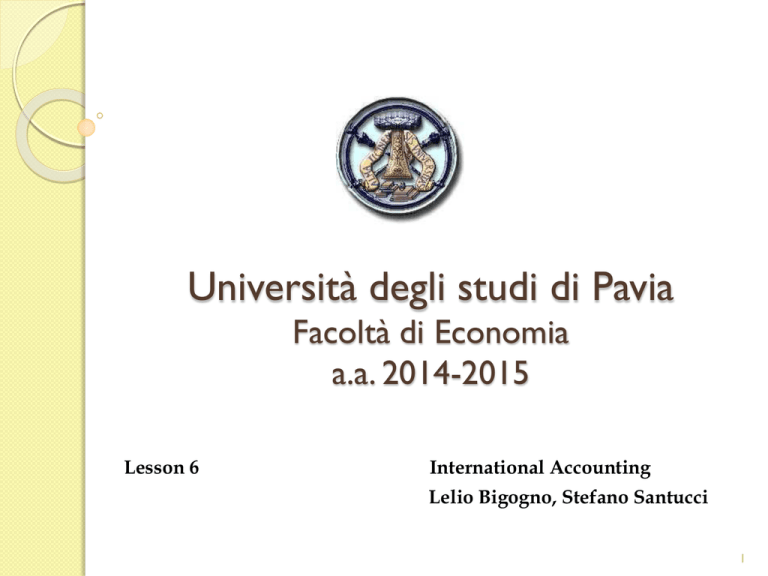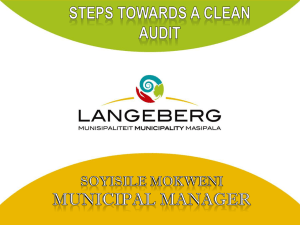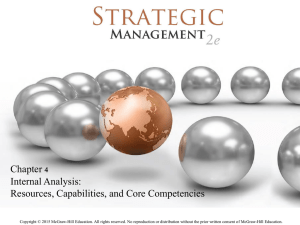Intangible Assets with finite life - Economia
advertisement

Università degli studi di Pavia Facoltà di Economia a.a. 2014-2015 Lesson 6 International Accounting Lelio Bigogno, Stefano Santucci 1 IAS/IFRS: Objective and definition of IAS38 2 The objective of IAS 38 is to prescribe the accounting treatment for intangible assets that are not dealt with specifically in another IFRS. The Standard requires an entity to recognise an intangible asset if, and only if, certain criteria are met. The Standard specifies how to measure the carrying amount of intangible assets and requires certain disclosures regarding intangible assets. 3 IAS 38 applies to all intangible assets other than: financial assets exploration and evaluation assets (extractive industries), for them a specific IFRS has been issued expenditure on the development and extraction of minerals, oil, natural gas, and similar resources intangible assets arising from insurance contracts issued by insurance companies intangible assets covered by another IFRS, such as intangibles held for sale (IFRS5), deferred tax assets, (IAS12) lease assets (IAS17), assets arising from employee benefits, and goodwill. Goodwill is covered by IFRS 3 (business combination). 4 Key Definitions Intangible asset: an identifiable non monetary asset without physical substance. An asset is a resource that is controlled by the entity as a result of past events (for example, purchase or self-creation) and from which future economic benefits (inflows of cash or other assets) are expected. 5 The three critical attributes of an intangible asset are: identifiability control (power to obtain benefits from the asset) future economic benefits (such as revenues, cash flow or decrease of future costs) 6 Identifiability: an intangible asset is identifiable when it is separable (capable of being separated and sold, transferred, licensed, rented, or exchanged, either individually or together with a related contract) or arises from contractual or other legal rights, regardless of whether those rights are transferable or separable from the entity or from other rights and obligations. Let’s try to understand…. 7 Examples of possible intangible assets : •computer software •patents •copyrights •motion picture films •customer lists •mortgage servicing rights •licenses •import quotas •franchises •customer and supplier relationships •marketing rights 8 Intangibles can be acquired: by separate purchase as part of a business combination by a government grant by exchange of assets by self-creation (internal generation) 9 IAS/IFRS: Recognition Criteria 10 IAS 38 requires an entity to recognise an intangible asset, whether purchased or selfcreated (at cost) if, and only if: 1. it is probable that the future economic benefits that are attributable to the asset will flow to the entity; and 2. the cost of the asset can be measured reliably. This requirement applies whether an intangible asset is acquired externally or generated internally. IAS 38 includes additional recognition criteria for internally generated intangible assets 11 The probability of future economic benefits must be based on reasonable and supportable assumptions about conditions that will exist over the life of the asset. The probability recognition assumption is always considered to be satisfied for intangible assets that are acquired separately or in a business combination. 12 If recognition criteria not met If an intangible item does not meet both the definition and the criteria for recognition as an intangible asset, IAS 38 requires the cost to be recognised as an expense when it is incurred. 13 Business combinations. There is a presumption that the fair value (and therefore the cost) of an intangible asset acquired in a business combination can be measured reliably. An expenditure (included in the cost of acquisition) on an intangible item that does not meet both the definition and recognition criteria for an intangible asset should form part of the amount attributed to the goodwill recognised at the acquisition date. 14 Reinstatement. The Standard prohibits an entity from subsequently reinstating as an intangible asset, at a later date, an expenditure that was originally charged to expense. 15 Initial Recognition: Research and Development Costs Charge all research cost to profit and loss Development costs are capitalised only after technical and commercial feasibility of the asset for sale or use have been established. This means that the entity must intend and be able to complete the intangible asset and either use it or sell it and be able to demonstrate how the asset will generate future economic benefits. 16 If an entity cannot separate the research phase of an internal project to create an intangible asset from the development phase, the entity treats the expenditure for that project as if it were incurred in the research phase only. YES, BUT HOW TO SEPARATE THEM? 17 Initial Recognition: In-process Research and Development Acquired in a Business Combination A research and development project acquired in a business combination is recognised as an asset at cost, even if a component is research. Subsequent expenditure on that project is accounted for as any other research and development cost (debited to profit and loss except to the extent that the expenditure satisfies the criteria in IAS 38 for recognising such expenditure as an intangible asset). 18 Initial Recognition: Internally Generated Brands, Mastheads,Titles, Lists Brands, mastheads, publishing titles, customer lists and similar intangible assets that are “internally generated” should not be recognised as assets. The problem is the measurement. 19 Initial Recognition: Computer Software Purchased capitalised Operating system for hardware: to be included in hardware cost Internally developed (whether for use or sale): charge to expense until technological feasibility, probable future benefits, intent and ability to use or sell the software, resources to complete the software, and ability to measure cost. Amortisation: over the useful life, based on pattern of benefits (straight-line is the default). 20 Initial Recognition: Certain Other Defined Types of Costs The following items must be charged to expense when incurred: internally generated goodwill start-up, pre-opening, and pre-operating costs training cost advertising and promotional cost, including mail order catalogues relocation costs 21 For this purpose, 'when incurred' means when the entity receives the related goods or services. If the entity has made a prepayment for the above items, that prepayment is recognised as an asset until the entity receives the related goods or services. 22 IAS/IFRS: Measurement 23 Initial measurement Intangible assets are initially measured at cost. 24 Measurement Subsequent to Acquisition: Cost Model and Revaluation Models Allowed An entity must choose either the cost model or the revaluation model for each class of intangible asset. 25 1. Cost model. After initial recognition the benchmark treatment is that intangible assets should be carried out at cost less any amortisation and impairment losses; 2. Revaluation model. Intangible assets may be carried out at a revalued amount (based on fair value) less any subsequent amortisation and impairment losses only if fair value can be determined by reference to an active market. Such active markets are expected to be uncommon for intangible assets. 26 Revaluated model….. Examples where they might exist: production quotas fishing licences taxi licences 27 Under the revaluation model, revaluation increases are credited directly to "revaluation surplus" within equity except to the extent that it reverses a revaluation decrease previously recognised in the statements of comprehensive income. If the revalued intangible has a finite life and is, therefore, being amortised (see below) the revalued amount is amortised. 28 Classification of Intangible Assets Based on Useful Life Intangible assets are classified as: Indefinite life: no foreseeable limit to the period over which the asset is expected to generate net cash inflows for the entity. NO DEPRECIATION REQUESTED. Finite life: a limited period of benefit to the entity. DEPRECIATION OVER THE FINITE LIFE REQUESTED. 29 Measurement Subsequent to Acquisition: Intangible Assets with finite life The cost less residual value of an intangible asset with a finite useful life should be amortised on a systematic basis over that life: •The amortisation method should reflect the pattern of benefits; •If the pattern cannot be determined reliably, amortise by the straight line method; •The amortisation charge is recognised in the profit or loss unless another IFRS requires that it be included in the cost of another asset; •The amortisation period should be reviewed at least annually; The asset should also be assessed for impairment in accordance with IAS 36 30 Expected future reduction in selling could be indicative of a higher rate of consumption of the future economic benefits embodied in an asset. 31 Revenue-based amortisation method The standard contains a rebuttable presumption that a revenue-based amortisation method for intangible assets is inappropriate. However, there are limited circumstances when the presumption can be overcome: - The intangible asset is expressed as a measure of revenue; and - it can be demonstrated that revenue and the consumption of economic benefits of the intangible asset are highly correlated. 32 Examples where revenue based amortisation may be appropriate IAS 38 notes that in the circumstance in which the predominant limiting factor that is inherent in an intangible asset is the achievement of a revenue threshold, the revenue to be generated can be an appropriate basis for amortisation of the asset. 33 Examples where revenue based amortisation may be appropriate The standard provides the following examples where revenue to be generated might be an appropriate basis for amortisation: - A concession to explore and extract gold from a gold mine which is limited to a fixed amount of revenue generated from the extraction of gold - A right to operate a toll road that is based on a fixed amount of revenue generation from cumulative tolls charged. 34 The asset should also be assessed for impairment in accordance with IAS 36 35 Subsequent Expenditure Due to the nature of intangible assets, subsequent expenditure will only rarely meet the criteria for being recognised in the carrying amount of an asset. Subsequent expenditure on brands, mastheads, publishing titles, customer lists and similar items must always be recognised in profit or loss as incurred. 36 Measurement Subsequent to Acquisition: Intangible Assets with indefinite life An intangible asset with an indefinite useful life should not be amortised. Its useful life should be reviewed each reporting period to determine whether events and circumstances continue to support an indefinite useful life assessment for that asset. If they do not, the change in the useful life assessment from indefinite to finite should be accounted for as a change in an accounting estimate. The asset should also be assessed for impairment in accordance with IAS 36. 37 Disclosures 38 For each class of intangible asset, disclose: useful life or amortisation rate amortisation method gross carrying amount accumulated amortisation and impairment losses line items in the statement of comprehensive income in which amortisation is included 39 reconciliation of the carrying amount at the beginning and the end of the period showing: additions (business combinations separately) assets held for sale retirements and other disposals revaluations impairments reversals of impairments amortisation foreign exchange differences other changes 40 basis for determining that an intangible has an indefinite life description and carrying amount of individually material intangible assets certain special disclosures about intangible assets acquired through government grants information about intangible assets whose title is restricted contractual commitments to acquire intangible assets 41 Additional disclosures are required about: intangible assets carried at revalued amounts the amount of research and development expenditure recognised as an expense in the current period 42









